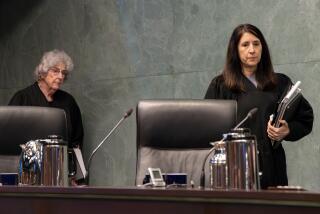Justices Give Older Workers More Leeway in Alleging Bias
WASHINGTON â The Supreme Court on Wednesday gave workers age 40 and older greater rights to sue an employer for age discrimination, even if there was no evidence that such bias was intentional.
The 5-3 ruling expands the reach of federal law against age discrimination by opening the door to lawsuits involving rules and requirements that do not mention the age of employees.
The decision affects about 75 million workers -- more than half the nationâs labor force, according to the Bureau of Labor Statistics.
But the justices said employers could successfully defend themselves against such claims if they could show they had a good business reason for adopting the policy.
âAge, unlike race ... [sometimes] has relevance to an individualâs capacity to engage in certain types of employment,â said Justice John Paul Stevens, who turns 85 in April and who wrote the majority opinion.
Nonetheless, he continued, older workers should be allowed to sue if they can point to a âspecific test, requirement or practice ... that has an adverse impact on them.â
Until now, the high court had said that older workers must show âintentional discriminationâ by an employer to win a claim under the Age Discrimination in Employment Act of 1967, which covers workers 40 and older. Early on, many of these claims targeted mandatory retirement rules based on age.
Lower courts had been split on whether the law allowed older workers to sue over a neutral policy that had an adverse effect on them because of their age.
As an example of such a case, lawyers said one such rule would be a job test that focused on computer literacy for a position that did not require computer use. Such a test may have an adverse effect on older applicants.
Another often-cited example is a layoff policy that targets high-salaried workers or those eligible for retirement benefits.
Lawyers who represent older workers applauded the outcome. âThis is a very good result, a huge victory for older workers,â said Laurie McCann, a lawyer for AARP, the nationâs largest lobbying group for seniors.
âThese cases will not be easy to win, but at least they can be brought in court,â she said.
The courtâs handling of the case decided Wednesday illustrated the complex nature of such suits and the high threshold needed to win claims.
A group of police officers in Jackson, Miss., sued the city when it gave bigger pay raises to officers who had less than five years on the job. Although this pay policy -- based on length of service -- was neutral in one sense, they contended, it had a âdisparate impactâ on them by unintentionally discriminating against the older employees and favoring younger ones.
The court unanimously threw out the lawsuit, ruling that the city had a good reason for its policy: It wanted to attract new officers and sought to bring its starting salaries up to the average in the region. The policy of giving bigger raises to younger officers âis unquestionably reasonable given the cityâs goal of raising employeesâ salaries to match those in the surrounding communities,â Stevens said in Smith vs. City of Jackson.
But in the more significant part of his opinion, Stevens spoke for the five-member majority in saying that the age-bias law did cover such claims of âdisparate impactâ discrimination.
Tom Goldstein, the Washington lawyer who represented the older police officers in Jackson, said the ruling would force some employers to think twice about policies that may unreasonably affect older employees.
âThis is a big win for the employees who donât have âsmoking gunâ evidence of discrimination, like a memo that says, âWe need some new blood around here,â â he said.
But business lawyers said they were not dismayed by the result.
âThe court has opened the door for disparate impact claims, but only by a narrow crack,â said Stephen Bokat, general counsel for the U.S. Chamber of Commerce. âIt will be a very narrow group of cases where plaintiffs can succeed.â
Paul Grossman, a management lawyer in Los Angeles, also said he did not expect the ruling to have a big effect on employers.
âThere are too many defenses available,â he said. âI frankly do not anticipate very many of these findings of disparate impact discrimination.â
Congress passed the age-discrimination law three years after it enacted the Civil Rights Act of 1964, which bars employers from discriminating against workers based on their race, gender or religion. The wording of the age law is nearly identical to the civil rights law, Stevens said.
Since the early 1970s, employees have been able to sue over job policies that have an adverse effect on them because of their race, gender or religion, and it makes sense that the same should be true of age-bias claims, Stevens said. His opinion was joined in full by Justices David H. Souter, Ruth Bader Ginsburg and Stephen G. Breyer.
The key vote was cast by Justice Antonin Scalia. He agreed with Stevens, but mostly because the U.S. Equal Employment Opportunity Commission had issued regulations saying the law against age bias included claims of âdisparate impactâ discrimination.
âThis is an absolutely classic case for deference to agency interpretation,â Scalia said, since the commission was charged with enforcing the law.
Justices Sandra Day OâConnor, Anthony M. Kennedy and Clarence Thomas dissented, arguing that the law meant workers must have âproof of discriminatory intentâ by the employer to win an age-bias claim.
The case was heard in November when Chief Justice William H. Rehnquist was recovering from surgery. He took no part in the decision.
More to Read
Get the L.A. Times Politics newsletter
Deeply reported insights into legislation, politics and policy from Sacramento, Washington and beyond. In your inbox three times per week.
You may occasionally receive promotional content from the Los Angeles Times.











